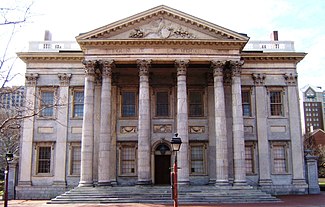First Bank of the United States
|
First Bank of the United States
|
|

3rd Street facade (2009)
|
|
| Location | 120 South Third Street Philadelphia, Pennsylvania |
|---|---|
| Coordinates | 39°56′53.25″N 75°8′48.45″W / 39.9481250°N 75.1467917°WCoordinates: 39°56′53.25″N 75°8′48.45″W / 39.9481250°N 75.1467917°W |
| Built | 1795 |
| Architect | Samuel Blodgett, possibly with James Hoban |
| Architectural style | Greek Revival, other |
| NRHP Reference # | 87001292 |
| Added to NRHP | May 4, 1987 |
The President, Directors and Company, of the Bank of the United States, commonly known as the First Bank of the United States, was a national bank, chartered for a term of twenty years, by the United States Congress on February 25, 1791. It followed the Bank of North America, the nation's first de facto central bank.
Establishment of the Bank of the United States was part of a three-part expansion of federal fiscal and monetary power, along with a federal mint and excise taxes, championed by Alexander Hamilton, first Secretary of the Treasury. Hamilton believed a national bank was necessary to stabilize and improve the nation's credit, and to improve handling of the financial business of the United States government under the newly enacted Constitution.
The First Bank building, located in Philadelphia, Pennsylvania, within Independence National Historical Park, was completed in 1797, and is a National Historic Landmark for its historic and architectural significance.
In 1791, The First Bank of the United States was one of the four major financial innovations proposed and supported by Hamilton, first Secretary of the Treasury. In addition to the national bank, the other measures were assumption of the state war debts by the U.S. Government, establishment of a mint and imposition of a federal excise tax. The goals of Hamilton's three measures were to:
In simpler words, Hamilton's four goals were to
"The tendency of a national bank is to increase public and private credit. The former gives power to the state for the protection of its rights and interests, and the latter facilitates and extends the operations of commerce amongst individuals."
According to the plan put before the first session of the First Congress in 1790, Hamilton proposed establishing the initial funding for the First Bank of the United States through the sale of $10 million in stock of which the United States government would purchase the first $2 million in shares. Hamilton, foreseeing the objection that this could not be done since the U.S. government did not have $2 million, proposed that the government make the stock purchase using money lent to it by the bank; the loan to be paid back in ten equal annual installments. The remaining $8 million of stock would be available to the public, both in the United States and overseas. The chief requirement of these non-government purchases was that one-quarter of the purchase price had to be paid in gold or silver; the remaining balance could be paid in bonds, acceptable scrip, etc.
...
Wikipedia
